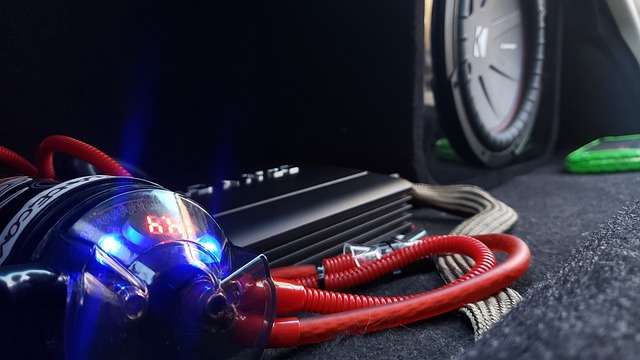Car audio aficionados understand the impact of a superior sound system on the driving experience. If you’re aiming to take your car audio setup to the next level, wiring a 4-channel amplifier to six speakers is a potent way to achieve unparalleled audio quality. While it may seem intricate at first, this step-by-step guide ensures a seamless and rewarding DIY project. Join us as we dive into the intricate details, offering valuable insights to not only connect components but to optimize your entire system for an audio journey like no other.
Before You Begin:
1. Gather Necessary Tools and Materials:
To embark on this sonic adventure, gather the tools and materials that will make your installation a breeze. Here’s your checklist:
- A 4-channel amplifier
- Six high-quality speakers
- Sufficient speaker wires
- Power wire and ground wire for the amplifier
- RCA cables for clean signal transmission
- Crimp connectors, wire stripper, and screwdriver set
- Panel removal tools for a seamless installation
- Drill and bits for secure mounting
2. Plan Your Speaker Placement:
Elevating your audio experience begins with strategic speaker placement. Consider the following factors:
- Optimal Locations: Identify prime locations for each speaker, factoring in visibility, sound distribution, and aesthetic appeal.
- Speaker Compatibility: Consult product manuals or the manufacturer’s website to confirm compatibility between your speakers and amplifier in terms of power handling and impedance.
- Balanced Soundstage: Aim for a balanced soundstage by strategically placing speakers, considering the interior layout of your vehicle.
3. Check the Amplifier and Speaker Specifications:
Before diving into the installation, a thorough review of specifications is imperative:
- Power Handling: Ensure the power handling capacity of your speakers aligns with the amplifier’s output capability, promoting optimal performance without risking speaker damage.
- Impedance Harmony: Match speaker impedance (measured in ohms) with the recommended range of the amplifier for efficient power delivery.
Wiring Process:
Step 1: Disconnect the Car Battery:
Safety is paramount in any DIY project. Begin by disconnecting the car battery to eliminate the risk of electrical accidents.
- Safe Disconnecting: Utilize the appropriate tools to disconnect the negative terminal, creating a safe working environment.
- Battery Location: Locate the car battery, typically found under the hood, and be aware that some vehicles may have additional batteries in the trunk.
Step 2: Install the Amplifier:
Choose an optimal location for the amplifier, ensuring both performance and longevity.
- Ventilation: Mount the amplifier where it can benefit from adequate ventilation, preventing overheating during operation.
- Accessibility: Prioritize accessibility for adjustments and maintenance, especially if the amplifier has manual controls or tuning options.
- Secure Mounting: Ensure a secure mounting to prevent vibrations from affecting performance.
Step 3: Run Power and Ground Wires:
Proper routing of power and ground wires is critical for optimal system performance.
- Routing the Power Wire: Run the power wire from the car battery to the amplifier’s positive terminal, protecting it with grommets and wire loom.
- Choosing the Ground Location: Connect the ground wire to a solid, unpainted metal surface on the car’s chassis, establishing a reliable ground connection.
- Ground Wire Gauge: Verify the appropriate gauge for the ground wire, consulting the amplifier manual for specific recommendations.
Step 4: Connect the RCA Cables:
Ensure a clean and noise-free signal transfer from the head unit to the amplifier.
- Identify Input Channels: Match the RCA cables to the corresponding input channels on the amplifier.
- Secure Connections: Guarantee secure connections for both the head unit and amplifier to avoid signal loss or interference.
- Routing RCA Cables: Prevent interference or noise by routing the RCA cables away from power wires and securing them with cable ties along existing routes.
Step 5: Run Speaker Wires:
Precise measurement and routing of speaker wires are essential for optimal audio distribution.
- Measuring Wire Length: Measure and cut speaker wires to the appropriate lengths, adding a bit of extra length for flexibility during installation.
- Crimping Connectors: Secure speaker wires to the amplifier and speakers using crimp connectors for reliable connections.
- Polarity Check: Double-check the polarity of speaker wires, ensuring correct connection to corresponding channels on the amplifier.
Step 6: Connect Speakers to Amplifier:
Proper connection of each speaker ensures balanced audio distribution and prevents phase issues.
- Positive and Negative Connections: Connect positive and negative wires from each speaker to the corresponding channels on the amplifier.
- Impedance Considerations: If speakers have different impedance ratings, distribute them evenly across the amplifier channels for a consistent load.
- Speaker Placement: Consider the physical placement of each speaker for an optimal soundstage and imaging.
Step 7: Secure and Conceal Wires:
Organize and secure wires for a visually appealing and trouble-free installation.
- Using Wire Ties: Employ wire ties to bundle and secure wires, preventing them from dangling or interfering with moving parts.
- Concealing Wires: Conceal speaker wires within the car’s interior panels or trim for a polished and professional appearance.
- Avoiding Damage: Ensure wires are not pinched or chafed by moving parts to prevent electrical shorts or damage.
Step 8: Reconnect the Car Battery:
With all connections secure, it’s time to reconnect the car battery.
- Reconnecting Procedure: Reconnect the negative terminal securely to prevent accidental disconnection while driving.
- Voltage Check: Use a multi-meter to check the voltage at the amplifier’s power terminal, ensuring it matches the vehicle’s battery voltage for a proper connection.
Step 9: Test the System:
With the car battery reconnected, it’s time to test and fine-tune your audio system.
- Power On Sequence: Power on the car audio system and amplifier, checking for any unusual noises during startup.
- Speaker Testing: Test each speaker individually to ensure proper functionality, addressing any issues promptly.
- Amplifier Settings: Adjust amplifier settings such as gain, crossover, and equalization to achieve the desired balance and sound quality. Consult the amplifier manual for optimal settings.
Conclusion
Congratulations! You’ve not only successfully connected the components but have masterfully optimized your entire car audio system. As you enjoy the fruits of your labor—cruising with a superior sound system that you’ve meticulously crafted—take pride in the fact that you’ve become a maestro in the art of wiring a 4-channel amp to six speakers.
Your vehicle is now a rolling symphony, providing not just transportation but a journey immersed in music. Share your newfound expertise with fellow car audio enthusiasts, and revel in the immersive soundscape you’ve created. Remember, the road ahead is not just a drive; it’s an auditory adventure. Safe travels, and enjoy the ride!
Featured Image by Ryan from Pixabay
You might also like,
The Comprehensive Guide to Connecting Your Car Amplifier’s Remote Wire

